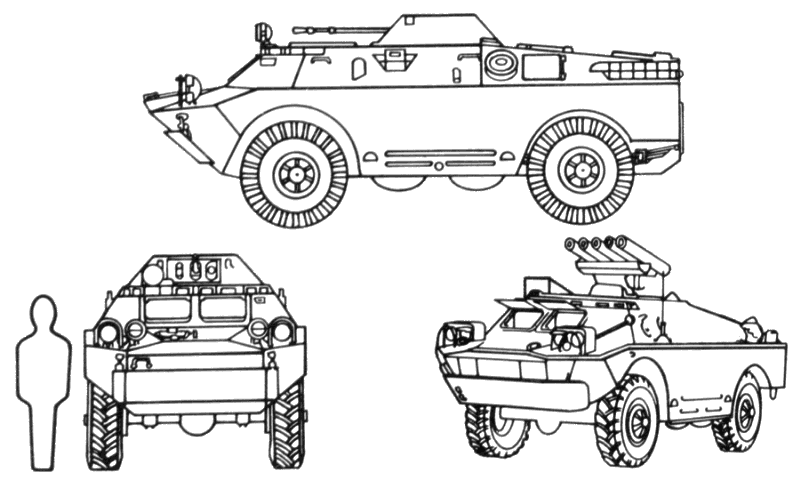The BRDM-2 (
Boyevaya Razvedyvatelnaya Dozornaya Mashina-2) was designed as the successor to the earlier BRDM-1.
Main improvements over the earlier BRDM-1 vehicles are the BRDM-2s fully-enclosed armament installation and more powerful rearmounted engine.
These improvements give the BRDM-2 a higher road clearance and better cross-country and water performance.
Externally it differs from the BRDM due to its larger, box-like hull.
The BRDM-2 has an all-welded steel hull with the engine at the rear.
The driver sits at the front of the vehicle on the left with the commander to his right.
The BRDM-2 is fully amphibious, being propelled through the water by a single waterjet.
The BRDM-2 is similar to the Hungarian FUG (OT-65) and FUG-70 amphibious scout cars which also have rear engines.
The distinguishing difference is the twin water jets of the Hungarian vehicles as compared to the single triangular water jet of the Soviet scout car.
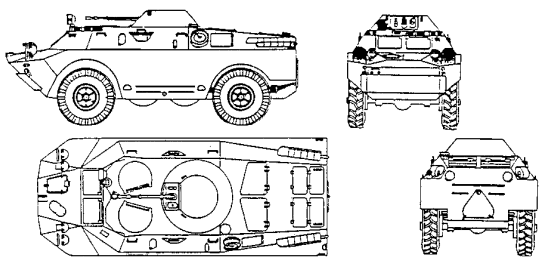
Polish modernized variant has been offered in five versions, with upgrades such as: 12.7mm MG, improved PKT MG mount, roof-mounted
AT-4 ATGM, surveillance radar, improved fire control, etc.
- BRDM-2
- 1963. Original production model. See data above.
Recognition features:
- A 4 x 4 truck chassis with two retractable rough terrain chain driven belly wheels on each side of the vehicle between the front and rear wheels.
- Tires that are not protected by armor and are particularly vulnerable to puncture by all kinds of fire.
- A rear-mounted engine with a short stubby hood.
- Box-shaped hull.
- Ship-like bow.
- A trim vane that is stowed under the nose of the hull when travelling and is erected at the front of the hull before entering the water.
- Exhaust pipes on each side of the hull.
- A troop compartment in the center of the hull.
- A winch mounted internally at the front hull.
- Small cone-shaped turret mounted over middle retractable wheels (no turret on command or ATGM versions).
- No roof hatch on the turret.
- An air inlet on the hull top, left of the turret.
- A bulletproof windscreen to the front of the driver and commander. An armored shutter hinged at the top covers the windscreen when the vehicle is in a combat area.
- Periscopes mounted at roof level around the front and sides of the driver's and commander's positions.
- Two circular roof entry hatches behind the driver and commander.
- A single firing port in each side of the hull. Immediately behind each of these firing ports are three vision blocks that protrude from the outside of the hull.
- Two air-inlet louvers in the forward engine compartment roof and four smaller air-inlet louvers to the rear.
- Infrared driving lights.
- An infrared searchlight mounted over the commander's position.
- A cruciform-shaped back with one waterjet cover that has a straight horizontal bottom.

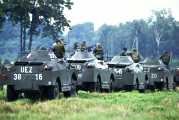
Exercise "Cooperative Bridge 94"
Biedrusko/Poznan, Poland
12-SEP-1994
NATO Photo
1024x686, 169K, JPEG
- BRDM-2Rkh
- NBC reconnaissance vehicle.
This version has two rectangular racks on each side of the hull at the rear that contain lane-marking poles with pennants.
The racks are normally covered with canvas and when required are positioned vertically over the rear of the vehicle.
The racks can fire the flags individually.
This allows a reconnaissance vehicle crew to rapidly survey and mark a contaminated area without disembarking from the vehicle.
There are two versions of this vehicle: the original Rkha with the standard 14.5mm KPVT heavy machine gun and the more usual Rkhb with twin 7.62mm machine guns and improved sensors.
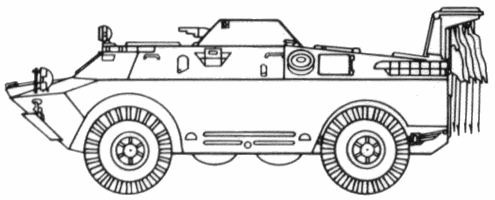

- BRDM-2U
- Command variant without a turret. The turret is replaced by a hatch that opens forward.
Mounted to the rear of this hatch is a communications equipment generator.
Two radio antennas are mounted one each side of the hull.
- SA-9
- SAM system transporter-erector-launcher vehicle.
The SA-9 (Gaskin) mobile surface-to-air missile system is based on a modified BRDM-2 (4 x 4) amphibious chassis with its belly wheels removed.
The original turret has been replaced by a one-man turret with an elevating arm on each side.
Mounted to each arm is a box-type launcher for the SA-9 fire-and-forget missiles.
To reduce the overall height of the system for travelling, the missiles are normally lowered into the horizontal position on each side of the vehicle.
No reserve missiles are carried on the SA-9 system.
In the Soviet Army and some other countries, the SA-9 is being replaced by the SA-13 Gopher SAM system on a modified MT-LB chassis.
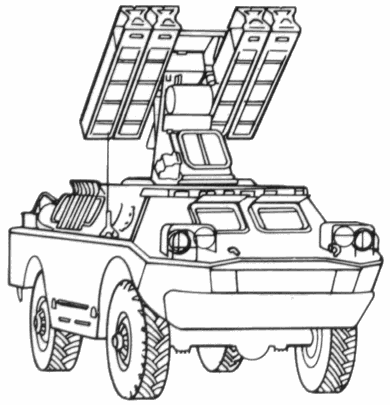
Anti-tank guided missile launcher vehicles:
- 9P122
- Variant with 6-rail AT-3 ATGM launcher.
This version is a BRDM-2 with its turret replaced with an arm, on top of which are mounted six Sagger AT-3 ATGWs.
When travelling the ATGWs are within the hull.
In combat, they are raised along with their overhead armor protection, above the top of the hull.
The missiles can be launched from within the vehicle or up to 80 meters away.
A total of eight missiles are carried in reserve and a radio antenna is fitted at the rear on the right side.
- 9P124 (BRDM-2 with Swatter-C ATGWs)
- Variant with 4-rail AT-2 ATGM launcher.
This version is similar in appearance to the BRDM-2 with the Sagger ATGW.
However, it has a quadruple launcher for the AT-2 ATGW and was converted from its original radio command-to-line-of-sight guidance to semi-active infrared/command guidance.
A total of eight Swatters are carried including the three in the ready to launch position.
As far as is known the improved Swatter has been fitted to the original BRDM-1 installation.
- 9P133
- Variant with 6-rail AT-3C SACLOS ATGM launcher.
- 9P137
- Variant with 5-rail AT-5 ATGM launcher.
This version is fitted with a turret on top of which is mounted five ready to launch missiles.
This vehicle is sometimes referred to as the BRDM-3.
To the rear of the turret in the top of the hull is a bowed hatch, which is thought to fold into the hull, enabling the launcher to be internally reloaded.
The launch tube has a blow-out cap at the front and is flared at the rear and a sight is fitted in the roof of the vehicle on the right side.
It is estimated that ten more missiles are carried inside the hull.
- 9P148
- Variant with 5-rail AT-4 or AT-5 ATGM launcher.
